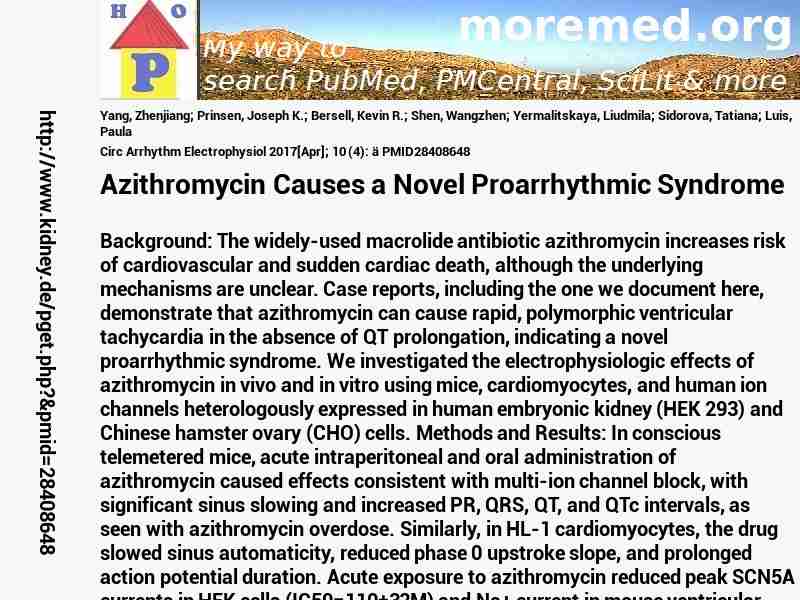
|
10.1161/CIRCEP.115.003560
http://scihub22266oqcxt.onion/10.1161/CIRCEP.115.003560

C5396181!5396181!28408648
 free free
 free free
 free free
Warning: file_get_contents(https://eutils.ncbi.nlm.nih.gov/entrez/eutils/elink.fcgi?dbfrom=pubmed&id=28408648&cmd=llinks): Failed to open stream: HTTP request failed! HTTP/1.1 429 Too Many Requests
in C:\Inetpub\vhosts\kidney.de\httpdocs\pget.php on line 215
|  
Warning: imagejpeg(C:\Inetpub\vhosts\kidney.de\httpdocs\phplern\28408648.jpg): Failed to open stream: No such file or directory in C:\Inetpub\vhosts\kidney.de\httpdocs\pget.php on line 117
 Circ+Arrhythm+Electrophysiol 2017 ; 10 (4): � Circ+Arrhythm+Electrophysiol 2017 ; 10 (4): �
Nephropedia Template TP
gab.com Text
Twit Text FOAVip
Twit Text #
English Wikipedia
|
Azithromycin Causes a Novel Proarrhythmic Syndrome #MMPMID28408648Yang Z; Prinsen JK; Bersell KR; Shen W; Yermalitskaya L; Sidorova T; Luis PB; Hall L; Zhang W; Du L; Milne G; Tucker P; George AL; Campbell CM; Pickett RA; Shaffer CM; Chopra N; Yang T; Knollmann BC; Roden DM; Murray KTCirc Arrhythm Electrophysiol 2017[Apr]; 10 (4): � PMID28408648show ga
Background: The widely-used macrolide antibiotic azithromycin increases risk of cardiovascular and sudden cardiac death, although the underlying mechanisms are unclear. Case reports, including the one we document here, demonstrate that azithromycin can cause rapid, polymorphic ventricular tachycardia in the absence of QT prolongation, indicating a novel proarrhythmic syndrome. We investigated the electrophysiologic effects of azithromycin in vivo and in vitro using mice, cardiomyocytes, and human ion channels heterologously expressed in human embryonic kidney (HEK 293) and Chinese hamster ovary (CHO) cells. Methods and Results: In conscious telemetered mice, acute intraperitoneal and oral administration of azithromycin caused effects consistent with multi-ion channel block, with significant sinus slowing and increased PR, QRS, QT, and QTc intervals, as seen with azithromycin overdose. Similarly, in HL-1 cardiomyocytes, the drug slowed sinus automaticity, reduced phase 0 upstroke slope, and prolonged action potential duration. Acute exposure to azithromycin reduced peak SCN5A currents in HEK cells (IC50=110�3?M) and Na+ current in mouse ventricular myocytes. However, with chronic (24hour) exposure, azithromycin caused a ~2-fold increase in both peak and late SCN5A currents, with findings confirmed for INa in cardiomyocytes. Mild block occurred for K+ currents representing IKr (CHO cells expressing hERG; IC50=219�21?M) and IKs (CHO cells expressing KCNQ1+KCNE1; IC50=184�12?M), while azithromycin suppressed L-type Ca++ currents (rabbit ventricular myocytes; IC50=66.5�4?M) and IK1 (HEK cells expressing Kir2.1; IC50=44�3?M). Conclusions: Chronic exposure to azithromycin increases cardiac Na+ current to promote intracellular Na+ loading, providing a potential mechanistic basis for the novel form of proarrhythmia seen with this macrolide antibiotic.�
  
DeepDyve
Pubget Overpricing | 
|